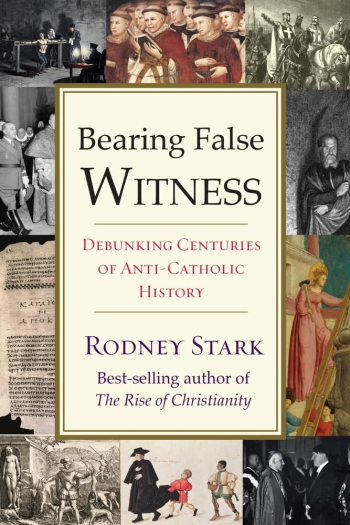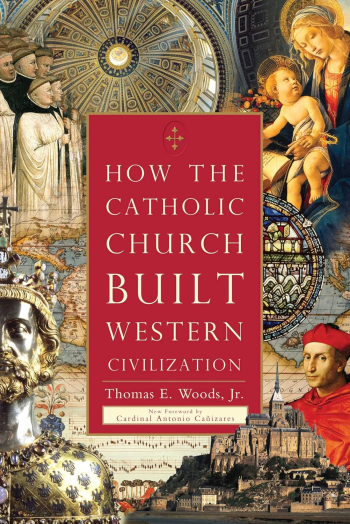Put on your thinking cap, brother. Read slowly. The following is not written by a Catholic, but by Rodney Stark, who is not defending Catholicism; he is defending history, so there is no 'Catholic bias'. I am not trying to gouge your eyes out, I am trying to inform you,
IF you can be humble enough to accept it.
”10 To summarize, Western history consists of four major eras:
(1) classical antiquity,
(2) then the Dark Ages when the Church dominated, followed by
(3) the Renaissance-Enlightenment that led the way to
(4) modern times.
For several centuries that has been the fundamental organizing scheme for every textbook devoted to Western history,11 despite the fact that serious historians have known for decades
that this scheme is a complete fraud—“an indestructible fossil of self-congratulatory Renaissance humanism.”12 It is appropriate to use the term “Renaissance” to identify a particular period in the arts when there was renewed interest in classical styles and to distinguish this period from the Gothic or the Baroque. But it is inappropriate to apply this term to identify the rebirth of intellectual progress following the Dark Ages because
there never were any Dark Ages.
Even the respectable encyclopedias now define the Dark Ages as a myth.
>The Columbia Encyclopedia rejects the term, noting that “medieval civilization is no longer thought to have been so dim.”
>Britannica disdains the term Dark Ages as “pejorative.”
>And Wikipedia defines the Dark Ages as “a supposed period of intellectual darkness after the fall of Rome.”
As for the recovery of classical learning, to the extent it ever was lost, Church scholars accomplished the recovery long before the Renaissance. And if one wishes to identify an Age of Reason, it must be redated to have begun very early in the Christian era, for the
Western faith in reason originated in Christian theology.
To assume that the sacking of the city of Rome in 410 by Alaric and his Gothic forces caused “the whole world to perish,” as Saint Jerome (347–420) lamented, is to assume that the only civilized people of that time lived in the city itself. But of course, true Romans lived all over the empire, and they didn’t suddenly become ignorant when the city fell. Indeed, at the time, Rome was not even still the capital of the empire; the emperor had moved to Ravenna. The fall of the city was, no doubt, of immense symbolic importance, but symbols should not be mistaken for reality. Of even greater importance,
the Goths who conquered Rome were not barbarians, regardless of what the Romans called them. Alaric had served as a commander in the Roman army, and the majority of his troops were Roman army veterans.
By the same token, the “barbarian north” had long since been fully “Romanized” and sustained sophisticated manufacturing centers with active trade routes even to the Far East.
For example, as early at 250 CE, the island city of Helgö near Stockholm, Sweden, was a flourishing industrial center turning out “large quantities of iron tools and weapons, bronze jewelry, gold ornaments, and other products … [including] locks and keys … [and] glass beads.” Coins found at the site of Helgö show it was involved in a vast trade network, and so does the finding of a “bronze Buddha figure made in India.”13 Nor was Helgö an anomaly: there were numerous industrial centers like it all over northern Europe,
home of the supposed barbarians.
Incredibly, not only
was there no “fall” into “Dark Ages,” this was “one of the great innovative eras of mankind,” as technology was developed and put into use “on a scale no civilization had previously known” as the French historian Jean Gimpel put it.14 In fact, it was during the Dark Ages that Europe took the great technological leap forward that put it ahead of the rest of the world.15 How could historians have so misrepresented things? In part, the notion that Europe fell into the “Dark Ages”
was a hoax perpetrated by very antireligious intellectuals such as Voltaire and Gibbon, who were determined to claim that theirs was the era of “Enlightenment.”
Another factor was that intellectuals too often have no interest in anything but literary matters. It is quite true that after the fall of Rome, educated Europeans did not write nearly as elegant Latin as had the best Roman writers. For many, that was sufficient cause to regard this as a backward time. In addition, during this era, only limited attention was paid to classical thinkers such as Plato and Aristotle, and that too was taken as proof of widespread ignorance.
Another component contributing to the
myth of the Dark Ages was that in this era there were no longer large cities having hundreds of thousands of residents, as had ancient Rome and Alexandria.16 It seemed obvious that high culture could not have been sustained in the small communities of medieval Europe—in the year 1000 there were only 20,000 inhabitants in Paris, not many more in London, and Rome had shrunk to fewer than 30,000.17 But perhaps the most important factor in the myth of the Dark Ages was the inability of intellectuals to value or even to notice the nuts and bolts of real life.
Hence, revolutions in agriculture, weaponry and warfare, nonhuman power, transportation, manufacturing, and commerce went unappreciated.
So too did remarkable moral progress. For example, at the fall of Rome there was slavery everywhere in Europe; by the time of the Renaissance it was long gone. But what is truly difficult to explain is how the creators of the Dark Ages myth could have overlooked what would seem to have been their chief interest:
high culture.
Nevertheless,
they missed or dismissed the enormous progress that took place in music, art, literature, education, and science. I have written at length in How the West Won (2014) on what truly took place during the mythical era of the Dark Ages. Here a summary will suffice.
Progress in Technology
-The Romans made little use of water or wind power—preferring manual labor performed by slaves.
-An inventory conducted in the ninth century found that one-third of the estates along the Seine River in the area around Paris had water mills,
the majority of them on Church-owned properties.18
-Several centuries later there was one mill every seventy feet along this stretch of the river!19
-Meanwhile, across the channel, the Domesday Book, compiled in 1086 as a forerunner of the modern census, reported that there were at least 5,624 water-powered mills already operating in England, or one for every fifty families, and this is known to be an undercount.20
-Among many other things, mills such as these mechanized the manufacture of woolen cloth and soon enabled England to dominate the European market.21
- Many dams also were constructed during the 'Dark Ages'; one at Toulouse, built around 1120, was more than thirteen hundred feet across and was constructed by driving thousands of giant oak logs into the riverbed to form a front and rear palisade and then was filled with dirt and stone.22
Some leading historians whose work informed this chapter.
Meanwhile, agriculture was revolutionized.24 First came the shift to a three-field system wherein one-third of the productive land was left unplanted each year while continuing to be cultivated (to remove weeds) and fertilized.
The result of this renewal of the land was far greater production. In addition, the invention of the heavy plow permitted far better cultivation of the wetter, denser soils north of Italy, and the introduction of the horse collar permitted the replacement of teams of slow oxen with teams of horses, thus
at least doubling the speed of cultivation. Selective plant breeding also began
in the monasteries, resulting in more productive and hardy crops.
Altogether these Dark Ages achievements fed a larger population much better and provided sustenance for larger urban populations. Also of immense importance was the
invention of chimneys, which allowed buildings and homes to be heated without needing holes in the roof to let out smoke while letting in rain, snow, and cold air.
Another revolutionary innovation was eyeglasses, which were invented in about 1280 and almost immediately went into mass production,
thus allowing huge numbers of people to lead productive lives who otherwise could not have done so.25 In 1492, when Columbus set out on his first voyage west, eyeglasses still were known only in Europe.
These are only a few of the important technological innovations achieved during the Dark Ages.
e’s household, that there are contentions among you. Now I say this, that each of you says, “I am of Paul,” or “I am of Apollos,” or “I am of Cephas,” or “I am of Christ.” Is Christ divided? Was Paul crucified for you? Or were you baptized in the name of Paul?



